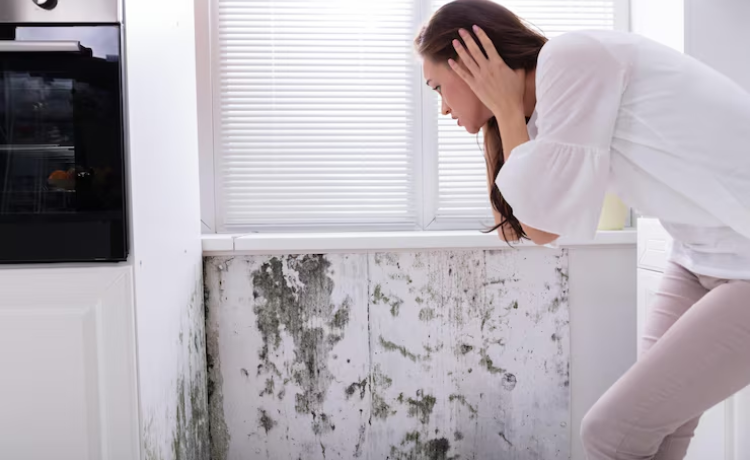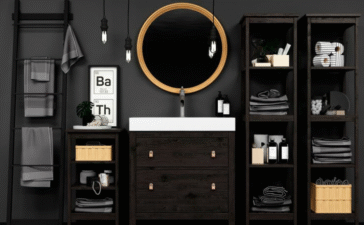Discovering dark, unsightly spots in your bathroom can be alarming. While it might just be mildew, it could also be the infamous black mold, a fungus that thrives in damp, dark environments. Understanding what black mold is, the risks it poses, and how to deal with it is crucial for maintaining a healthy home. This guide will walk you through everything you need to know, from identifying and preventing black mold in bathroom to safely removing it and knowing when to call in the professionals.
What is black mold in bathroom?
Not all dark mold is “the” black mold, but it’s important to recognize the potential culprit. Knowing how to spot it early can save you significant trouble and expense down the line.
Understanding Black Mold
The term “black mold” most often refers to a specific species called Stachybotrys chartarum. This greenish-black mold is known for its slimy texture when wet. It releases mycotoxins, which can be harmful to human health. You might find it growing on materials with high cellulose content that have been exposed to prolonged moisture, such as drywall, ceiling tiles, and wood. In the bathroom, it can appear on tiles, in grout lines, around fixtures, and even on painted walls. Identifying these early signs of black mold in bathroom spaces is the first step toward protecting your home and your health.
How Does Black Mold Form in Your Bathroom?
Black mold requires a specific environment to grow, and bathrooms often provide the perfect conditions. The primary causes of black mold in bathroom are consistent moisture and poor air circulation. This environment is created by several factors, including high humidity from hot showers, condensation on cool surfaces like mirrors and windows, and water leaks from pipes, faucets, or even a compromised roof. Without proper bathroom mold prevention strategies, such as adequate ventilation, these damp conditions create a breeding ground for mold spores to settle and multiply.
Health Risks of black mold in bathroom
Exposure to black mold is more than just a cosmetic issue; it can have significant health implications, particularly for sensitive individuals.
Health Hazards from Exposure to Black Mold
The mycotoxins produced by Stachybotrys chartarum are the primary source of black mold health risks in the bathroom. When inhaled or touched, these toxins can cause a range of symptoms. Common reactions include persistent coughing, sneezing, irritated eyes, a runny nose, and skin rashes. For individuals with pre-existing respiratory conditions, such as asthma, exposure can trigger more severe attacks. Long-term exposure has also been linked to headaches, fatigue, and difficulty concentrating.
The risks are especially high for vulnerable groups. Children, the elderly, pregnant women, and people with weakened immune systems may experience more severe and rapid-onset symptoms. For these individuals, prompt and thorough mold removal is not just recommended—it’s essential.
How to Prevent Black Mold in Your Bathroom
The most effective strategy for dealing with mold is to prevent it from growing in the first place. A few proactive steps can make your bathroom an inhospitable place for mold.
Preventive Measures for Black Mold Growth
Effective bathroom mold prevention starts with controlling moisture. One of the most critical steps is maintaining proper ventilation. Always use an exhaust fan during and after showers or baths, and let it run for at least 30 minutes to clear out humidity. If you don’t have a fan, opening a window can help. The EPA recommends keeping indoor humidity below 50%. Another key measure is to ensure your bathroom is properly sealed. Check the caulking around tubs, sinks, and toilets to prevent water leaks that can seep into walls and floors.
Maintenance Tips to Avoid Mold
Regular maintenance is crucial for keeping mold at bay. Clean and inspect your grout and tiles regularly for any signs of discoloration. If you spot a water leak from a pipe or faucet, fix it immediately to stop moisture buildup before it becomes a problem. When renovating, consider using mold-resistant products. Many companies now offer mold-resistant drywall, paints, and primers specifically designed for high-humidity areas like bathrooms. A routine bathroom mold inspection can help you catch potential issues early.
How to Remove Black Mold from Bathroom Walls, Tiles, and Grout
If you’ve discovered black mold, your next step is removal. Depending on the size of the infestation, you may be able to handle it yourself.
DIY Methods to Remove black mold in bathroom
For small, contained areas of black mold, a DIY approach can be effective. You can use common household cleaning agents like white vinegar, baking soda, or hydrogen peroxide. Commercial mold removers are also available. When learning how to remove black mold in bathroom, always prioritize safety. Wear protective gear, including non-porous gloves, safety goggles, and an N-95 respirator mask. Ensure the area is well-ventilated by opening windows and using fans. Apply your cleaning solution, let it sit, and then scrub the area firmly with a brush before rinsing and drying it completely.
When to Call a Professional for Black Mold Removal
DIY methods are not suitable for every situation. You should call for professional mold removal if the mold covers an area larger than 10 square feet, if you suspect it’s growing behind walls or under flooring, or if you or your family members are experiencing worsening health symptoms. Professionals have the specialized equipment and training to safely contain and eliminate large-scale infestations, preventing spores from spreading to other parts of your home.
Black Mold vs. Mildew: How to Tell the Difference?
It’s easy to confuse black mold and mildew, as both thrive in similar conditions. However, they have distinct differences.
Key Differences Between Black Mold and Mildew
When comparing black mold vs. mildew in the bathroom, look at their appearance and texture. Mildew is typically a powdery, surface-level fungus that appears gray, white, or sometimes yellow. It’s often found on grout lines or shower curtains. Black mold, on the other hand, is usually slimy or fuzzy and can be dark green or black. It often indicates a more significant moisture problem, as it penetrates deeper into materials. While mildew can cause mild allergic reactions, the health impact of black mold is generally considered more severe due to its mycotoxins.
Common Bathroom Areas Affected by Black Mold
Mold can grow anywhere there’s moisture, but some areas in the bathroom are particularly vulnerable.
Top Areas in the Bathroom Where Black Mold Grows
High-risk areas for black mold growth include shower stalls and around tubs, especially in grout lines and along caulk seals. You should also check under sinks where leaks can go unnoticed, behind toilets, and around window sills where condensation collects. Black mold in bathroom grout and on tiles is common because these surfaces are constantly exposed to water. Under-cabinet spaces and areas behind wallpaper are also prime spots for hidden mold growth.
DIY vs. Professional Mold Removal: What’s More Cost-Effective?
Deciding whether to tackle mold removal yourself or hire a professional often comes down to cost and the extent of the problem.
Estimating the Cost of Black Mold Removal
The cost of DIY black mold removal is relatively low, consisting mainly of cleaning supplies and protective gear. However, the true cost includes your time and effort. Professional mold removal costs can vary significantly, ranging from a few hundred to several thousand dollars. The price depends on the size of the infestation, the location of the mold, and the extent of the damage. While the upfront cost of professional services is higher, it can be more cost-effective in the long run by ensuring the problem is solved correctly the first time.
Benefits of Professional Mold Inspection and Removal
When facing an extensive infestation, the benefits of professional mold remediation are clear. Experts use advanced techniques like containment and air scrubbing to prevent cross-contamination. They can also identify and address the root cause of the moisture problem. Ignoring a serious mold issue can lead to hidden costs, including structural damage to your home and ongoing health problems, which can be far more expensive than hiring a professional from the start.
You should aslo check: “bathroom set in black“
Best Products for Black Mold Removal in the Bathroom
Choosing the right products is essential for effectively and safely removing mold.
Top Cleaning Products and Solutions for Bathroom Mold
A variety of effective mold removal products are available. For a natural approach, a solution of equal parts white vinegar and water is a popular choice. For more stubborn mold, commercial mold and mildew sprays containing bleach or other strong fungicides can be very effective. After cleaning, applying a mold-resistant sealant to grout and caulk can help prevent regrowth. When painting, look for the best mold-resistant bathroom paints and primers, which contain antimicrobial agents to inhibit mold growth.
Never Ignore Black Mold in Your Bathroom
black mold in bathroom is a serious issue that should never be ignored. It not only damages your home but can also pose significant health risks to you and your family. By understanding what causes it, taking preventive measures, and acting quickly when you spot it, you can protect your property and well-being. Regular cleaning, proper ventilation, and prompt leak repairs are your best defenses.
If you’re facing a mold problem that seems too big to handle, don’t hesitate. Reach out to a certified professional for a thorough mold inspection and cleaning service to ensure your home is safe and healthy.
FAQs
What causes black mold in bathroom?
The primary causes of black mold in bathroom are excess moisture and poor ventilation. Activities like showering create a humid environment, and if this moisture isn’t properly vented, it leads to condensation on surfaces. Leaky pipes, faucets, or toilets also contribute to the damp conditions that allow mold spores to thrive.
Is black mold in bathroom dangerous?
Yes, black mold (Stachybotrys chartarum) can be dangerous. It produces mycotoxins that can cause a range of health issues, including respiratory problems, allergic reactions, headaches, and skin irritation. The risks are higher for vulnerable individuals like children, the elderly, and those with compromised immune systems.
What’s the best way to prevent black mold in bathroom?
The best prevention strategy is to control moisture. Use an exhaust fan during and for 30 minutes after every shower, fix any leaks immediately, and maintain indoor humidity below 50%. Regularly clean and dry surfaces, and consider using mold-resistant paint and caulk in your bathroom.
Can I remove black mold myself or should I hire a professional?
You can remove small patches of black mold (less than 10 square feet) yourself using appropriate safety gear and cleaning solutions. However, for large infestations, or if you suspect mold is hidden behind walls, it is crucial to hire a professional. They have the expertise and equipment to handle the removal safely and effectively.
How can I tell if the mold in my bathroom is toxic?
While only lab testing can definitively identify the mold species, any mold should be treated as a potential health risk and removed promptly. If the mold is black or dark green, slimy, and accompanied by a musty odor, it could be toxic black mold. If you experience health symptoms like persistent coughing or headaches, it’s best to consult a professional.
How can I safely handle black mold in bathroom?
When cleaning black mold, always wear personal protective equipment, including an N-95 mask, gloves, and safety goggles. Ensure the area is well-ventilated. Isolate the contaminated area if possible to prevent spores from spreading. After cleaning, dry the area thoroughly.
Is black mold covered by home insurance?
Home insurance coverage for mold damage varies widely. Many standard policies exclude mold damage unless it is the direct result of a covered peril, such as a sudden pipe burst. It’s essential to review your policy and speak with your insurance agent to understand what is covered.












